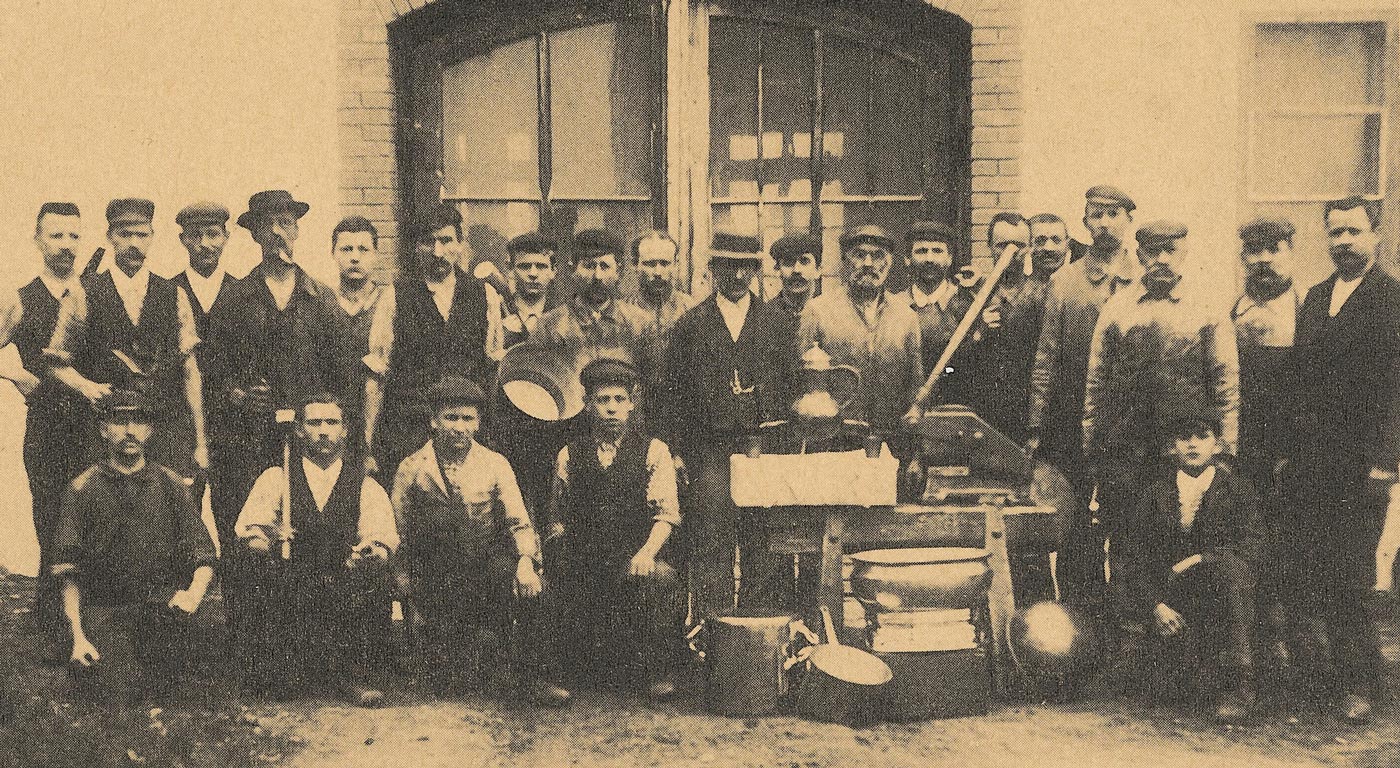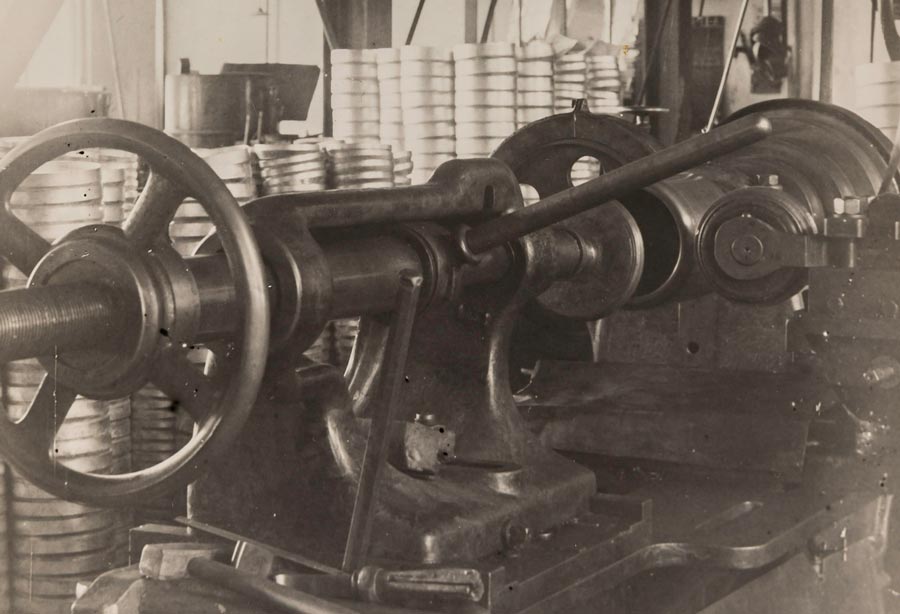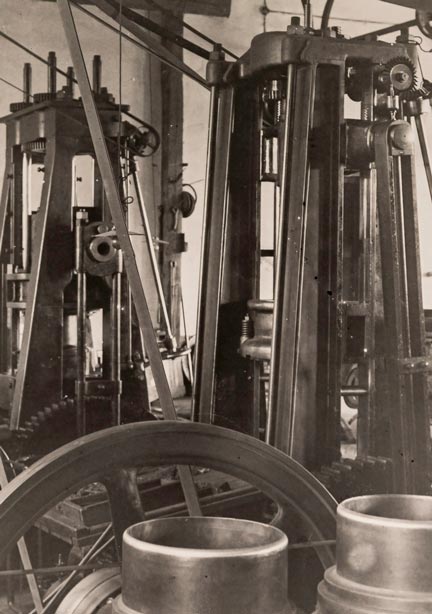-
Free delivery over CHF 80.-
-
Delivery within 2-3 working days
-
Climate neutral delivery
-
Swiss E-Commerce Award

 ch en
ch en
 Toggle Nav
Toggle Nav
EXPERIENCE BASED ON LONG TRADITION
TIME TRAVEL FROM “PFANNI” TO THE KUHN RIKON COMPANY OF TODAY


START
FOLLOW US FROM “PFANNI” TO THE KUHN RIKON COMPANY OF TODAY


How did a metal goods factory come to Tösstal, a valley far from all main transport routes, and actually a stronghold of the textile industry? The location is even more surprising when one considers that all these companies emerged during an era in which neither roads nor railway lines led to the valley, which was annually flooded by the Töss river.
All the villages were up on the high plateau. Down in the valley, there were only a couple of lone farmsteads – in safe coves such as Zell and Rykon.
1819
FIRST BEGINNINGS –
THE RYKON SPINNING MILL IS FOUNDED


When the first spinning machines became available around 1800, countless spinning mills sprung up along the Töss. The wild water river was diverted along newly dug canals to power water wheels. A whole range of new textile machines accelerated the development. One by one, manual jobs were replaced by industrial manufacturing processes.
Spinning by hand was soon followed by machine spinning, hand weaving by mechanical looms, and hand-embroidery by machine embroidery. The Rykon spinning mill was a part of this upswing. It was founded in 1819 by Dr Bleuler, on the site which now belongs to Kuhn Rikon. On a map dating from 1843-1846, no fewer than 8 spinning mills and 4 mills are charted along a 9km stretch of river.
1899
«PFANNI» IS BORN – THE RYKON SPINNING MILL BECOMES A METALWORKING FACTORY


The Rykon spinning mill was hit hard by the first textile crisis. As a result, it became a metal- working factory: the Kindlimann brothers’ tin & coppersmith factory. A hard-working coppersmith and armourer had founded an oven-making factory in the forest. His sons, Jakob and Albert Kindlimann, persuaded their father to begin producing and selling cooking utensils along with the ovens.


The factory thus began manufacturing cauldrons and pans from mainly galvanised copper and sheet iron. The new line of production flourished, and soon the workshop was too small. After acquiring the “Rykon spinning mill” at a bargain price, the two sons began to expand in the direction of Rikon. Hence eighty years later, the former textile factory became the first metal-working factory in the region – the Kindlimann Rykon die-cutting factory, commonly referred to by the locals as “Pfanni”.
1914
SMILE, PLEASE!
THE WORKFORCE EXPANDS TO 24 EMPLOYEES


The 24 employees of Kindlimann Brothers Pan Factory pose for a photograph in front of the main entrance. They proudly present one of their most important tools: metal shears. But peening hammers, peening anvils, compression benches and beading machines were also used to shape the soft, pliable copper into pots and pans.




The original peening machine (operated by hydropower) and the beading machine are now on display in the Kuhn Rikon museum. These machines were used up until 1940.
1924
FIRE - THE FACTORY BURNS DOWN TO THE GROUND


On an icy cold winter’s night in February 1924, the factory building was burned to the ground. The cause of the fire remained unresolved. Thankfully, there were no casualties, and insurance paid for the damage. In 1924/25, the new factory building was erected around 200m further on. To this day, this has served as the headquarters for Kuhn Rikon Company.
1926
THE START OF A SUCCESS STORY


The company ran into financial difficulties following high investments after the fire and the death of entrepreneur Thiriet. Heinrich Kuhn, who had worked up until this time as a mining engineer in Alsace / France, acquired «Pfanni» – the former copper and steel pan factory “Thiriet & Cie”.


HEINRICH KUHN
Heinrich Kuhn originally came from Rüti-Rain, and was one of six children. His parents’ farm could not provide a livelihood for all the offspring, so Heinrich and two of his brother sought alternative employment.
After completing an apprenticeship as a metalworker with Heinrich Bosshard in Bischofszell, Heinrich Kuhn managed to secure a place at the Technology College in Winterthur. The course of study, which lasted for six semesters, was not easy, as he had to work in order to pay back his parents for his board and lodging. Heinrich had to lead the cattle to pasture at 4am, clean the stables, and then catch the train to Winterthur – where he must often have felt like falling asleep at his desk.
In 1898, with his diploma in his pocket, Heinrich Kuhn emigrated to the Alsace. Here, the mechanical engineer became a mining engineer. Before the war, the German region was ceded to France, and the deep drilling company «gute Hoffnung», owned by the Société de Sondages, was renamed «Bonne Espérance». Kuhn’s work was utterly destroyed during the first world war; even the life insurance policies he had taken out were made worthless by inflation.
His father-in-law Jakob Boller from Turbenthal was worried about his daughter and the two children, so asked them to return to Switzerland.
In 1925, an opportunity to do so arose in Rikon. Now 48 years old, Heinrich Kuhn-Boller decided on impulse to return, seeing a chance in acquiring Thiriet & Cie.
The risk was high and the transition difficult. Starting over again in Switzerland after 27 years, in an unfamiliar industry, in a run-down company. Purchased with his savings, totalling 100,000 Swiss Francs, and 300,000SF borrowed money. In his diary, he wrote: “In my own home and my own company for the first time!” One can almost feel his excitement and hope for a positive future.
1927
KUHN RIKON DEVELOPS THE «DURO», THE FIRST COOKWARE SUITABLE FOR ELECTRICAL HOBS


Following initial losses – and sometimes even forgoing his own salary – the tide changed. As electricity found its way into more and more kitchens, so did electrical hobs – for which the cookware used to date proved to be unsuitable. When cooking over an open fire, little attention needs to be paid to the base of a pan. But if a pan is being used on an iron hob, the base needs to be completely flat. Only then can heat be distributed evenly and the food cook properly.
Heinrich Kuhn, working on behalf of the electrical oven manufacturer THERMA from Schwanden, developed special pans for electrical hobs, using a material which was relatively new at the time: aluminium.


UNCHARTED TERRITORY IN THE KITCHEN
Not only did Kuhn develop suitable cookware for these new hobs; he also invented the processes that made manufacture possible in the first place. He commissioned the Menziken aluminium foundry to produce gravity die casting from pure aluminium, and processed this using his special patented procedure to make his own brand of pans for electric hobs – DURO. At the same time, he equipped his pans with the first ever heat-proof handles. As the plastics we have today had not yet been invented, these consisted of die-cut fibre discs pressed together.
DURO cookware and electric hobs complemented each other perfectly, and the success of the duo was certain.
Women, who were primarily the ones responsible for cooking in those days, were delighted with the new hobs and the lightweight pans. Thus the company soon found itself with a solid base on which to build. The foundation stone for an innovative portfolio of products was laid.
1932
TOO SOON, TOO YOUNG –
HEINRICH KUHN DIES UNEXPECTEDLY


Just as the company began to flourish, a dark shadow cast its gloom over Heinrich Kuhn. His vision deteriorated year by year. Eventually, completely blind in one eye, Heinrich Kuhn was faced with another weighty decision: to go blind in both eyes, or undergo an operation to remove a brain tumour.
The operation, which was extremely complicated in those days, was not successful. Kuhn died, leaving a widow with two young sons and a leaderless company which was just beginning to grow. And this after just seven years of independence!


ENTERS THE COMPANY HENRI KUHN
Thus the metalworking factory in the valley of the textile industry met with yet more obstacles.
A new beginning was necessary. Thankfully, the brothers Jakob and Eugen Boller, both successful entrepreneurs in the textile industry, were able to team up with Heinrich Kuhn’s nephew, engineer Adolf Kuhn, to support the helpless widow Julia Kuhn-Boller. The company became a joint stock company. All three men agreed spontaneously to be on the board of directors. Thus the first generation change was completed.




HENRI KUHN
Henri Kuhn, the older son, had to leave school at the age of eighteen, before completing his “Matura”, the Swiss school leaving certificate. His first entry in the salary book lists him as a “controller”. Particularly the older employees regarded the unexperienced youth as a “spy” sent by the board of directors. It was a particularly humiliating start for the teenager.
To top it all, the Great Depression hit. This also affected the young joint stock company. At just 20 years of age, Henri was faced with difficult decisions regarding wage cuts, redundancy and liquidity.
Switzerland felt the burden of high levels of unemployment. Consumption slumped. These were difficult starting conditions for the young Henri Kuhn. But he didn’t lose heart or waste time. His interest was soon awakened, and he went to work resolutely.
With the help of his cousin Adolf Kuhn, who knew the company from former employment, the inspired “controller” was able to make a breakthrough.
1947
TWO MANAGERS – JACQUES KUHN JOINS THE COMPANY




At last, Henri Kuhn – who had to begin work at such an early age – was able to share responsibility with his brother. At 28 years of age, Jacques Kuhn returned from America, where he had studied mechanical engineering, and joined the company as technical director. Henri Kuhn took care of the sales, marketing and administration side of business. Jacques Kuhn focussed on product development and manufacture.
For 22 years, the two brothers worked side by side, and succeeded in securing a considerable share of the Swiss market for cookware. The company grew, employing a workforce of more than 130 persons.
1949
DEVELOPMENT OF THE DUROMATIC®BECOMES A MILESTONE


When the DUROMATIC® pressure cooker was launched, it marked an important milestone in the success of the company. By combining a spring valve with a bayonet lock, Jacques Kuhn produced a remarkable innovation.
His pressure cooker was quieter, more efficient and safer. And cooking times were reduced by a third compared to conventional cooking methods. The product swiftly advanced to become a market leader in Switzerland, and the name DUROMATIC® became a generic name for pressure cookers. In shops, customers no longer asked for a pressure cooker; they asked for a DUROMATIC®.
Over the following years, the product continued to improve with further patents, and the company was able to break through to the international market.


1964
TIBETANS ON THE RUN – KUHN RIKON HELPS


The Swiss confederation made a memorable decision to take in Tibetan families. Henri and Jacques Kuhn spontaneously offered their support, and provided the families with jobs and company accommodation.


In the Tobelsteig district, Kuhn Rikon created a modern housing complex which included apartment blocks, allotment gardens and playgrounds for children. Fewer than five minutes away from the workplace, the employees were able to move into very reasonably priced accommodation in apartments or houses. Being close to work and having time for their families and hobbies are factors which play an important role in employee satisfaction.
1969
ALONE AGAIN - HENRI KUHN DIES UNEXPECTEDLY


On 18th October 1969, Henri Kuhn died completely unexpectedly at the age of just 55 – like his father. His brother Jacques was now solely responsible for the management of the company. The strict division of work, which had always proven to be so efficient, now showed its drawbacks: besides product development and production, Jacques suddenly had to familiarise himself with the sales, marketing and administration of the company – areas which his brother had managed so well.
1970
FORM FOLLOWS FUNCTION, OR: “FROM THE OVEN TO THE TABLE”.


Kuhn Rikon began to pick up on customer requirements and develop cookware which was as aesthetically pleasing as it was functional. A pan which could be used not only for cooking, but also for serving. The original text of the advertising brochure from this period states:
«…Cooking, frying and serving in the same pan makes life easier for modern housewives…»


Gender roles may have changed since then, but consumers – whether men or women – still want practical solutions. The «Tavola» idea later developed into DUROTHERM® and HOTPAN®. These work on the same principle to make cooking easier.
Incidentally, the red lid – first used on the DUROMATIC® – was a visual recognition factor for high-quality Kuhn Rikon products for many decades.
1975
THE FIRST DOUBLE-WALLED COOKWARE
DUROTHERM® IS LAUNCHED




The first double-walled cookware with triple use for cooking, serving and keeping food warm was patented world-wide with the brand name DUROTHERM®, and launched onto the market.


The product was awarded gold medals at the inventor trade fairs in Geneva (1978) and Vienna (1979). To this day, Kuhn Rikon is the only company to have mastered the challenging production of double-walled cookware.




1980
UNITED KINGDOM – THE FIRST SUBSIDIARY IS FOUNDED


After decades of successful exports, Kuhn Rikon founded its first subsidiary company in England.
1982
SPAIN – EXPANSION AND HOLDING


Just two years later, the company founded a further branch in Spain. The company’s pressure cookers are particularly popular in Spanish kitchens. Beans, stews and typical Spanish dishes are much faster to prepare in pressure cookers. The branch is located in Cuarte, near Zaragoza.
The same year, Kuhn Rikon acquired a share in the French cookware company Baumlin SA. Based in Witisheim in the Alsace, the company not only manufactures stainless steel products, but also copper and laminated copper products for high end catering. Or for star chefs such as Paul Bocuse – read more in the entry for 1985.
1984
THIRD GENERATION AND ISO CERTIFICATION


Jacques Kuhn retired. He handed over the management of the company to physicist Dr. Wolfgang Auwärter-Kuhn and engineer Hans-Heinrich Kuhn. The same year, Kuhn Rikon became the first company in the consumer goods industry to be awarded ISO 9001 SQS certification.
1985
EXCLUSIVE COOKWARE FOR MONSIEUR PAUL


The culinary skills of Paul Bocuse – chef of the century and an icon of nouvelle cuisine – have been reflected for decades in his three Michelin stars. In his restaurant «L’Auberge du Pont de Collonges», he uses only the choicest ingredients – and the very best cookware.


By his order, Kuhn Rikon / Baumlin SA manufactured a cookware series named «Paul Bocuse», which was sold in France.


1988
KUHN RIKON GOES USA


The Kuhn Rikon Corporation USA was founded together with Rudy Keller. Keller completed a business apprenticeship in Rikon, and later gained valuable experience in the USA as representative of the company. Realising that the American market had huge potential, he decided to part ways with the trading company and take business into his own hands.
After years of successful expansion work, the American market is now one of the most important markets for Kuhn Rikon.
2002
KUHN RIKON IS AWARDED A PRIZE FOR OUTSTANDING MARKETING


Kuhn Rikon was awarded a prestigious marketing trophy. This was conferred on the company by the Swiss Marketing Club SMC in category 2 (companies with 50 to 299 employees).
The jury praised the concentrated advertising campaign «Heiss angerichtet» (“Served hot”), which was deployed both on the Swiss market and for export markets.
The photo shows the happy winners as the results are announced (from the left): Monika Maeder, head of marketing; Werner Blessing, managing director; Dr Wolfgang Auwärter, president of the board of directors.
2005
IN-HOUSE PRODUCT DESIGN DEPARTMENT IS FOUNDED


The strategy: to target innovative developments, shorten the time to market, and further develop the Kuhn Rikon design language. The first commission was to reinterpret the “cook, serve, keep warm” concept, work with colour, and find alternative methods.
2006
HOTPAN® IS THE FIRST PRODUCT TO LEAVE THE NEW IN-HOUSE DESIGN DEPARTMENT




After just one year of development, the first product left the new in-house design department and was ready to be launched on the market: the HOTPAN®. This product is available in five sizes and colours. Following its global launch, the product was showered with international design awards.
The SWISS MADE product is not only aesthetically pleasing, but also outstandingly functional. Not only does this cookware save up to 60% electricity costs; it can also keep food warm for up to two hours.
2009
HAPPY BIRTHDAY DUROMATIC®


Jacques Kuhn’s invention celebrated its 60th anniversary. DUROMATIC® pressure cookers can be found in just about every household in Switzerland. Since being launched onto the market in 1949, more than 10 million DUROMATIC® pressure cookers have been sold.
2012
THE FOURTH GENERATION STEPS IN


The fourth generation of the Kuhn and Auwärter-Kuhn owner families take responsibility of the board of directors (from left Philipp Kuhn, Dorothee Auwärter, Christian Kuhn and Willi Auwärter).
2014
DOROTHEE AUWÄRTER BECOMES CHAIRWOMAN OF THE BOARD OF DIRECTORS


In April 2014, Dorothee Auwärter became chairwoman of the board of directors. She is now the fourth generation to represent the owner family.
2019
A KITCHEN MIRACLE TURNS SEVENTY


Around 12 million classic DUROMATIC® pans have been sold around the world to date. And because it’s virtually indestructible, and replacement parts are still readily available, one can assume that most of these are still in use to this day. Pressure cooker number 293 was in use until very recently. Following a house clearance, it was returned to the production site in Rikon – where it now takes pride of place in the Kuhn Rikon Museum.
The latest DUROMATIC® not only communicates with us via an app, suggesting menus and telling us what to do, but also interacts with specially equipped hobs to control the entire cooking process.

 SWITZERLAND
SWITZERLAND  SCHWEIZ
SCHWEIZ  SUISSE
SUISSE  FRANCE | BELGIQUE | LUXEMBOURG
FRANCE | BELGIQUE | LUXEMBOURG  ESPAÑA
ESPAÑA  DEUTSCHLAND | ÖSTERREICH
DEUTSCHLAND | ÖSTERREICH  USA
USA  UK
UK  IRELAND
IRELAND  CHINA
CHINA 







